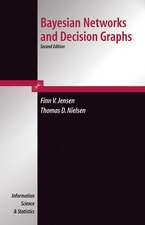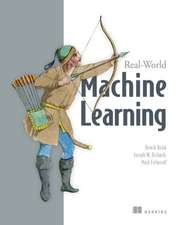Expert Systems Lab Course: Springer Compass International
Autor Peter Schnupp, Chau T. Nguyen Huu, Lawrence W. Bernharden Limba Engleză Paperback – 23 aug 2014
Preț: 337.20 lei
Preț vechi: 421.49 lei
-20% Nou
Puncte Express: 506
Preț estimativ în valută:
64.53€ • 67.68$ • 53.71£
64.53€ • 67.68$ • 53.71£
Carte tipărită la comandă
Livrare economică 01-15 aprilie
Preluare comenzi: 021 569.72.76
Specificații
ISBN-13: 9783642743054
ISBN-10: 3642743056
Pagini: 392
Ilustrații: XI, 374 p. 4 illus.
Dimensiuni: 155 x 235 x 21 mm
Greutate: 0.55 kg
Ediția:Softcover reprint of the original 1st ed. 1989
Editura: Springer Berlin, Heidelberg
Colecția Springer
Seria Springer Compass International
Locul publicării:Berlin, Heidelberg, Germany
ISBN-10: 3642743056
Pagini: 392
Ilustrații: XI, 374 p. 4 illus.
Dimensiuni: 155 x 235 x 21 mm
Greutate: 0.55 kg
Ediția:Softcover reprint of the original 1st ed. 1989
Editura: Springer Berlin, Heidelberg
Colecția Springer
Seria Springer Compass International
Locul publicării:Berlin, Heidelberg, Germany
Public țintă
ResearchCuprins
1 Introduction.- 1.1 What Do We Mean by Expert System?.- 1.2 What Is Prolog?.- 1.3 Which Implementation of Prolog Are We Using?.- 1.4 How Is This Lab Structured?.- 2 Characteristics and Components of an Expert System.- 2.1 The Concept and Areas of Application.- 2.2 Human Versus Machine Knowledge.- 2.3 Knowledge Base and Knowledge Bank.- 2.4 Rule Knowledge.- 2.5 The Inference Engine.- 2.6 Instantiation of Variables.- 2.7 Applications Problems.- 2.8 Classification of Typical Expert Systems.- 3 A Model System for Transit Fare Information.- 3.1 The Problem.- 3.2 Transit Fare Rules.- 3.3 Conducting a Dialog.- 3.4 Control Structure and the Rule Interpreter.- 3.5 Gathering Case Data.- 3.6 The Inference Tree and Protocolling.- 3.7 Explanations.- 3.8 Equivalent Answers.- 3.9 Weaknesses and Possible Improvements.- 4 The Representation and Processing of Knowledge.- 4.1 System Architecture.- 4.2 System Development.- 4.3 Modularization.- 4.4 Knowledge Structures and Deductive Mechanisms.- 4.5 Production Systems.- 4.6 The Direction of Chaining.- 4.7 Inference Trees.- 4.8 Rule Modification and Non-monotonic Logic.- 4.9 Control of Flow.- 5 Dialog and Explanatory Components.- 5.1 Implicit Dialog Texts.- 5.2 The Structure and Processing of Rules.- 5.3 Facts and Degrees of Certainty.- 5.4 The Inference Engine.- 5.5 Gathering Case Data.- 5.6 Vague Knowledge.- 5.7 Instructing the User to Perform a Test.- 5.8 Explaining the Reason for a Question.- 5.9 Presenting and Explaining the Results.- 5.10 “Why Not” Explanations.- 5.11 Listing the Current Contents of the Fact Base.- 5.12 Shortcomings and Possible Improvements.- 6 “Experience” and “Learning”.- 6.1 User Hunches.- 6.2 Diagnostic Phases.- 6.3 Heuristics.- 6.4 Diagnostic Statistics.- 6.5 Learning from Experience.- 6.6Shortcomings and Possible Improvements.- 7 Object-Oriented Knowledge Management.- 7.1 Objects, Instances and Classes.- 7.2 Representing Objects with Frames.- 7.3 The Organization of an Object Base.- 7.4 Primitive Operations for Managing Objects.- 7.5 The Knowledge Base for Software License Administration.- 7.6 The Primitives for Accessing Objects.- 7.7 Displaying Complex Structures.- 7.8 The “System” as an Object.- 7.9 Shortcomings and Possible Improvements.- 8 Frames and Procedures.- 8.1 Interactive Definition of New Objects.- 8.2 The Dialog for Constructing a New Object.- 8.3 Acquiring and Evaluating User Input.- 8.4 Procedural Components.- 8.5 Managing Free Format Text in External Memory.- 8.6 Assistance Systems for Information Preparation.- 8.7 Building an “Intelligent” Index Manager.- 8.8 Shortcomings and Possible Improvements.- 9 The Representation and Use of Constraints.- 9.1 Configuration and Selection Systems.- 9.2 The “Coupling Expert”.- 9.3 Functions and the Structure of Knowledge.- 9.4 Characteristic Object Data.- 9.5 Entering and Displaying Objects.- 9.6 Primitive Access Predicates.- 9.7 Represention of the Computational Formulas.- 9.8 Constraints on the Coupling Selection.- 9.9 The Complete Analysis of a Coupling.- 10 Embedding the System.- 10.1 Dialog Flow.- 10.2 The Menu Interface.- 10.3 Displaying Objects.- 10.4 The Selection of Objects.- 10.5 Maintaining a Protocol.- 10.6 Applying Metaknowledge.- 10.7 Preparing a Suggestion for Coupling Construction.- 10.8 Shortcomings and Possible Improvements.- 11 Software Development Methodology.- 11.1 “Knowledge-Based” Software Technology.- 11.2 Project Flow.- 11.3 Problem Specification.- 11.4 The Prototype.- 11.5 The Organization of Knowledge.- 11.6 Inference Strategies.- 11.7 Modularization ofthe Knowledge Base.- 11.8 Knowledge Representation.- 11.9 Representing Metaknowledge.- 11.10 Metasystems.- 11.11 Project Execution.- A The “MTA Expert”.- A.1 Start-up Procedure.- A.2 Module “mta”.- A3 Module “controlling”.- A.4 Module “dialog”.- A.5 Module “explanation”.- A.6 Module “aux-programs”.- A.7 Module “rule-base”.- B The System for Finding Defects in Automobile Heaters.- B.1 Start-up Procedure.- B.2 Module “main_prog”.- B.3 Module “knowledge-base”.- B.4 Module “test-aids”.- B.5 Module “dialog”.- B.6 Module “aux-predicates”.- B.7 Module “init”.- B.8 Module “explanation”.- B.9 Module “hypotheses”.- B.10 Module “learn”.- B.11 Module “endless”.- C The License and Memo Manager.- C.1 Initialization Procedure.- C.2 Start-up Procedure.- C.3 Module “primitives”.- C.4 Module “frames”.- C.5 Module “attachments”.- C.6 Module “help”.- C.7 Module “memos”.- C.8 Module “input-output”.- D The “Coupling Expert”.- D.1 Start-up Procedure.- D.2 Module “drive”.- D.3 Module “load”.- D.4 Module “assembly”.- D.5 Module “coupling”.- D.6 Module “frame”.- D.7 Module “gen_frames”.- D.8 Module “reading”.- D.9 Module “show”.- D.10 Module “fillout”.- D.11 Module “constraints”.- D.12 Module “procedures”.- D.13 Module “requirement”.- D.14 Module “controlling”.- D.15 Module “auxiliary_pred”.- D.16 Module “explanation”.- D.17 Module “metaknowledge”.- Further Reading.




















